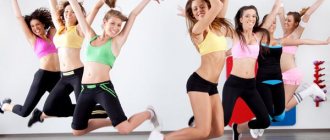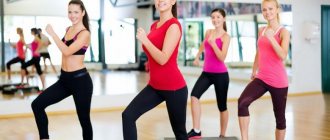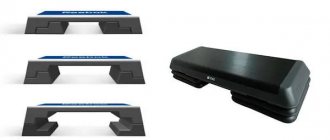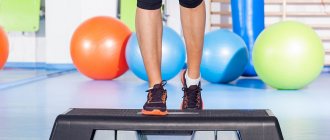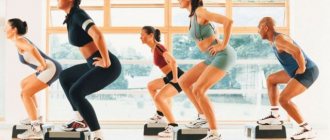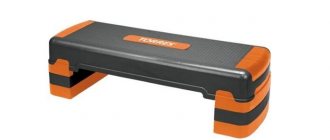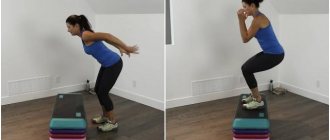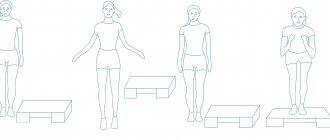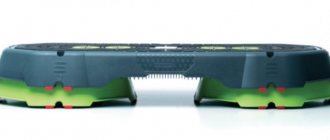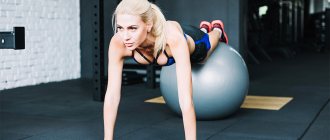The basic steps of step aerobics are quite simple, the main thing is to perform them correctly and to the rhythm of the music.
This article discusses the basic steps that are used in step aerobics, and also provides their decomposition by counting. Step aerobics is in many ways similar to classical aerobics, so many of the names are probably already familiar to you. But still, as in any area of fitness, it has its own characteristics.
Having mastered these basic steps, you can move on to more complex modifications, and step aerobics classes will become more varied and interesting every day!
What is Step Basic?
This type of aerobic exercise was developed by fitness instructor Gina Miller quite by accident when she was trying to restore her knee after an injury. Instead of a simulator, she used ordinary steps, for which she developed special exercises. Feeling how effective they were, Gina created a whole complex for working at elevated levels, thereby laying the foundation for Step Aerobics.
Step aerobics is a successful combination of aerobic and strength exercises on platforms of different heights, which are performed to energetic music.
The necessary equipment for training is a platform, which has special requirements. It must be strong, stable and wide enough so that a person of any height and build can easily stand on it with both feet. As for height, it all depends on your goals and level of training: the higher the platform, the more effective the exercises will be, but also the more difficult it will be to complete them.
Steps without changing the leading foot
Basically, such movements are made in four beats. They all have a name.
MARCH
They are the usual steps in place, alternately performed with two legs. They are done in 4 beats: first with the left, then with the right, and so on, or vice versa.
MAMBO
They are done in the same way as the previous ones, but the leading leg is first brought forward, then back. For example, the right leg steps forward, the left leg is in place, then the right leg is back, and the left is in place again.
One type of movement is to extend the leg diagonally.
V-STEP
The step is so called because of the similarity of the pattern performed by the limbs. When the right limb leads, it moves forward and to the right, after which the left limb moves forward and to the left. Then the right limb leads again, and the movements are made in the opposite direction. Thus, you need to return to the point from which you started. Either leg can lead.
CROSS
This is a rather difficult movement for beginners, since the legs must be crossed during the process. If the left foot leads, it is placed forward and to the right, the right one is left to the right, and the left one is put back in place, then the right one is placed next to it.
What muscles are being worked?
Step aerobics can be safely called a universal workout, because it involves elements of choreography, strength and cardio exercises, and at the same time, classes are conducted in a playful way to rhythmic music.
By choosing Step Basic to improve your figure, you can be sure that noticeable results will be achieved in the shortest possible time. This type of fitness practice is incredibly dynamic and burns calories very quickly; An additional bonus is the development of major muscle groups, strengthening of the cardiovascular system and a noticeable increase in endurance of the entire body.
Since the main load goes to the lower part of the body, it is quite natural that the legs work the most, in particular the thigh muscles and calf muscles. It should be remembered that the higher the platform, the stronger the impact on the floor, and the greater the load on the legs. Accordingly, as a result of such training, the muscles will become more prominent and toned, with a beautiful shape. If the goal is to reduce the volume of your legs, then you should opt for a low platform.
However, not only the legs are involved in step aerobics: the arms move in concert with the whole body and also receive their share of the load, especially if the trainer decides to introduce elements of strength training and suggests picking up small dumbbells.
Another undeniable advantage is excellent coordination of movements, truly royal posture and flying gait!
What is step aerobics?
Step aerobics is rhythmic gymnastics using a step platform. It was invented by American bodybuilder Jean Miller, who, after a knee injury, needed to engage in rehabilitation exercise. The doctor recommended lifting and lowering the milk crate every day. Jean found this boring, and she slightly improved the exercise: instead of a box there were porch steps, turns and light jumps were added to the descent and ascent, and all this was performed to rhythmic music. Today, step aerobics is the most popular area among group programs and is practiced in every, even the smallest fitness club, in all corners of the planet. And if Jean “invented” step aerobics without leaving home, is it right to think that you can only do it in the gym? Take a sturdy box at home or go to the porch step and ask yourself this question again.
What level of training should be for Step Aerobics?
Step aerobics classes are available to absolutely everyone, regardless of age, gender and level of physical fitness. However, there is a catch in them, which you should prepare for in advance. For beginning athletes, Step may seem like a very exciting activity, but already during the first training session all the excitement fades away, and the desire to come again no longer arises. The thing is that this fitness practice is characterized by fast movements that are difficult to repeat the first time. If a beginner is lucky enough to get into a more experienced group, he will have to get used to and adapt - after a couple of lessons, confidence will come, and the movements will be much better.
An ideal option for people with poor physical fitness would be special groups for beginners, where everyone together learns the intricacies of step aerobics.
Basic steps in aerobics
All steps in aerobics are tied to the beat of music in two or four counts. They are considered classic movements and can be combined in 8, 16 and 32 measures. Multi-beat steps are difficult for beginners, so the coach pronounces them and performs them together with the students. However, the basic steps in aerobics are the basis of all movements, which can be compared to knowing the alphabet to read.
When preparing a composition, it must include at least one movement from various groups. About ten additional elements are also added that the athlete can choose himself.
Movement groups have four difficulty levels. Also in the complex there should be two elements called the figure eight and the step track. The first includes a bunch of movements that are performed one after another for a duration of 4 beats. A step sequence in sports aerobics is a combination of different types of steps for sixteen counts. This may include jumping, swinging, lunging, and so on. Steps, running and skip, which are the main elements, are inserted only for connection.
Classic aerobics includes two main types of steps:
- Aerobic steps without changing the leading leg. It is assumed that the leg that began the step will begin all further movements.
- Steps with a change in the leading leg. Here the other limb will begin all steps.
What equipment is needed?
Step Basic classes require a special platform, which looks like a small portable step. It comes in different sizes, and the height can vary from 10 to 30 centimeters.
The step platform can be one-, two-, or three-level, depending on the complexity of the planned workout. In this case, models can be either fixed or adjustable height.
As a rule, high-quality step aerobics equipment is made of durable plastic with a compacted or rubberized surface. This is necessary so that your feet do not slip during exercises.
Choosing training shoes
Fitness practice Step Basic involves a lot of stress on the legs, in particular on the ankle. It is for this reason that you should never wear slippers, socks, moccasins or ballet shoes - any soft shoes without securely fixing your feet - to training.
The only acceptable option for training is comfortable sneakers with high soles (1 - 2.5 centimeters) and good shock absorption. Only such shoes will be able to take on the bulk of the load when the foot hits the floor or platform, protecting the spine from overstrain.
Can I do Step Basic at home?
Step aerobics has no restrictions in the form of complex simulators or special conditions for training. It is for this reason that classes can be carried out at home, you just need to purchase a platform and enjoy studying in a calm environment.
In order for classes to take place without any incidents, you need a fairly spacious room for exercises on the step platform, free time (about 1 hour) and, of course, the desire to practice!
Currently, you can find a lot of video lessons on the Internet for both beginners and more advanced levels. But if you don’t have confidence in your abilities, at first it’s better to take group classes to figure out what’s what, and then start training on your own.
Step aerobics. Basic stepsconsultation on the topic
Step aerobics - basic steps
This article discusses the basic steps in step aerobics, and also provides their decomposition by counting. In step aerobics there are no steps in two counts - a minimum of four. After all, we need to not only move along the floor, but also climb onto the platform. Step aerobics movements are performed with the entire foot placed on the step platform. Be careful not to let your heel drop or place your foot on your toes.
In step aerobics, there are specific terms that refer to the steps involved in performing step exercises. The steps in step aerobics are very diverse.
There are two types of steps in step aerobics:
— Steps without changing the leading foot. The leading foot is the foot with which you begin to step into a new musical measure. You can perform any steps of this type for as long as you like, and you will still start each beat on the same foot.
— Steps with a change of leading leg. With the next step, you will begin the movement with the other leg.
Step aerobics. Steps:
1.Step touch (step touch) - usually start with side steps on the floor, from left to right and vice versa.
2.Basic step (basic step) (the step is performed in 4 counts) - stepping onto the step is the simplest basic step, in fact we just climb onto the platform and get off it. Step one foot straight onto the step platform, step the other foot straight onto the step platform, step the first foot off the step platform, step the other foot off the step platform.
3.Step-up - you first need to step on the corner of the step platform with your right foot, and just touch the toe with your left foot. Then step completely with your left, and place your right toe behind your left. Then return to the floor and alternate legs. During this step, you need to keep your balance, since one support goes to one leg. You can't skew to one side.
4.Step-knee - The right leg needs to be placed on the step, the left leg should be bent at the knee and raised towards the stomach. The movements should be as natural as possible and you should not throw yourself to one side and twist your knee. The leg is pointed straight, the body tends slightly forward when lifting the knee.
5.Step kick - step onto the platform with your right foot, sharply throw your left foot forward, simulating a kick (do not raise your leg high)
6.Step-back (step-back) - step with one foot onto the step platform, lift the other leg back due to the tension of the gluteal muscles (shin overlap). This exercise perfectly strengthens the buttocks in motion.
7.V-step (V-step) - a step that resembles the letter V, for this you need to step onto the step alternately with two feet on opposite corners of the step. Alternately step with your feet on opposite corners of the platform, your legs move as if along the upper corners of the English letter V.
8.Basic-over - to do this, you need to step your right foot onto the step platform, place your left foot, step down from the step on the other side, turn to the left edge of the step and repeat with the other leg.
9.Mambo - dance movement - while the left foot is on the floor, the right foot steps onto the step, placing an emphasis and putting a point and immediately taking a step back with a point.
10. Straddle (straddle up) (step performed in 8 counts) - steps - legs together, legs apart. Step no is performed as follows: we climb onto the step platform, alternately place our feet on the floor on one side and the other of the platform, climb onto the platform again, and return to the starting position.
11.Turn step (Turn step) step with a turn - stand sideways to the platform. This is the same basic-step, only we descend from the step platform not backwards, but sideways. Step right onto the platform, step left onto the platform, with your back turned to the main direction (lengthwise to the platform), legs apart. Step the right one back in a diagonal direction (turning diagonally), step the right one back from the platform, bring the left one to the right one (starting position).
12.Ove the top (over the top) - Step across the platform. The starting position is in a longitudinal stance, sideways to the platform. Step left to the side to stand on the platform, place the right one. Step with your left foot to step off the platform (on the other side), place your right foot on half toes to your left foot.
13.Cha-cha-cha (cha-cha-cha) - steps with stepping from foot to foot to change legs.
14.L-step (8 steps) - step with one foot to the corner of the step platform (with the right foot we step to the left corner and vice versa), transfer the weight to this leg, lift the second leg up, bent at the knee, place the second leg on the floor on the side of the step -platform (from the short edge), transfer the weight to it, lift the first leg bent at the knee, place the first leg again on the step platform and transfer the body weight to it, lift the second leg up bent at the knee, return the second leg to the floor in front of the step -platform (in the place from which the entire step began), place the first foot on the floor next to the second.
Walk correctly! And train your body!
Contraindications
Despite all the obvious benefits of this fitness practice, there are still a number of contraindications to it, among which are:
- any diseases of the cardiovascular system;
- problems with the spine;
- hypertension;
- chronic kidney and liver diseases;
- problems with leg joints.
If you have any doubts about your health, it is best to consult a doctor before starting training to avoid possible problems with your health. To quickly master the Step Basic technique, you can sign up for a specialized fitness tour, giving you the opportunity to work out with a competent and attentive trainer.
